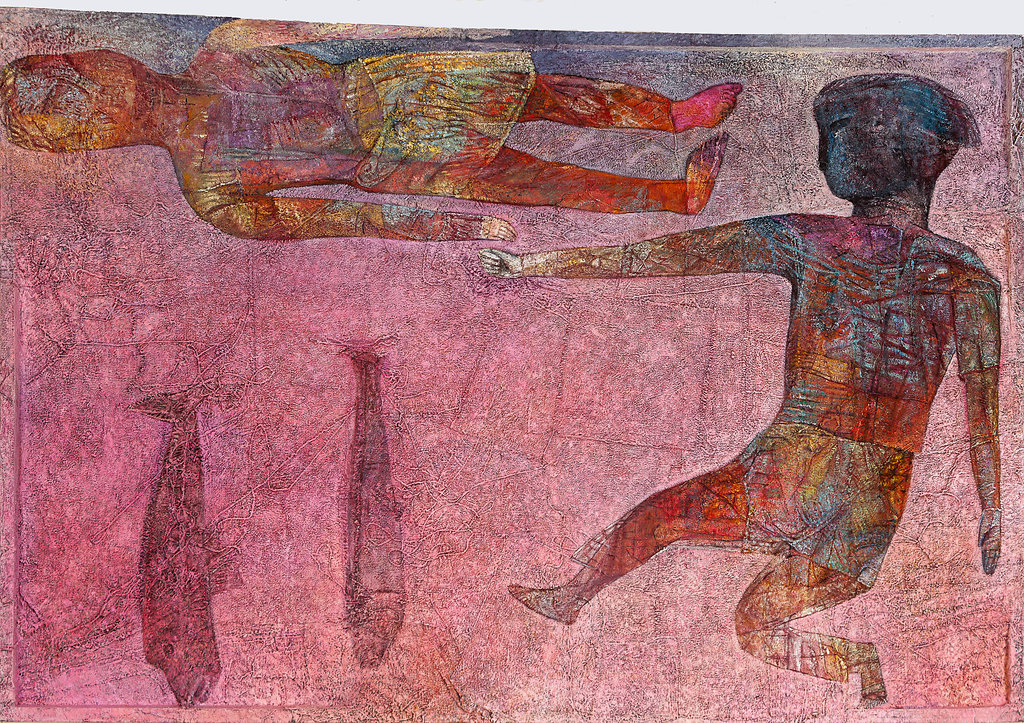The first thing to be said about lockdown is the overwhelming effect it has had on our environment. I have been amazed at how quickly nature repairs itself when we humans get out of the way. This has been a wake-up call for our senses: the air is better, the sound is richer, smells are more apparent and a sighting of animals rarely seen is rejuvenating.
I couldn’t imagine how the isolation of lockdown would affect working in my studio at all. After all painting is already a solitary process and it would not bring any change to my schedule. I was wrong. Lockdown has been a valuable experience in the world and within the confines of my studio.
To make sense of these developments I need to begin with a bit about my work process. I have long rejected the notion of a pre-designed image. My paintings are born out of randomly made surfaces. My battle is working without control. The resulting images are not for me to explain, but for others to determine. I can only talk about the journey that leads to the image. In recent works I have been trying to create from a deeper place. This requires leaving a lot behind: ego, comparison, control. This state is riddled with self-doubt and is not an easy place to be. It requires trust, listening and unforced continuation. I have found that it takes more energy to abandon control than to control. My interest lies in inward events rather than the dramas of the external. This requires stillness to the core, which once found is sometimes hard to maintain. Life provides many diversions to temporarily avoid the difficult, but a return to the uncomfortable is inevitable. Moments like these remind me of Orwell’s Coming Up for Air. As a child, George Bowling discovers a secret, dark, deep pool, the home of a huge elusive fish. It’s everything he wants, but he neglects to go back until he is an adult and then finds that it has been replaced with a man-made pond.
What I hadn’t expected from lockdown was that less contact with people would mean that my public persona would not be in use. This has had a quietening effect. No ruffling of the psyche. My intellect has taken a more passive role and given my instincts more space to function. This has benefited the particular state in which I have chosen to work.
We all have an external life and an internal life. Removing the external patterns of behaviour creates a clearer path to the internal. Our culture and education pay little attention to our interior lives, at worst deny their existence.
Relinquishing control is an unappetising, scary prospect and cause for much avoidance in my experience. I should imagine that the artists (first publicly valued by Dubuffet), whose work comes under the title of Art Brut and Outsiders don’t have this problem. Many of these artists’ lives are in a permanent state of lockdown/solitude.
All this may seem like a retreat from the chaos of the world at the moment. Perhaps this has finally come to light to so many because we have been afforded the time to focus without distraction. I have found that working inward gives clarity to outward events. Our external and internal lives are wisdoms that are linked. We need both.
– Phillippa Clayden, June 2020
Phillippa Clayden completed her BA at Central School of Art & Design and her Post-Graduate Diploma at the Royal Academy Schools. She studied life drawing for six years under Cecil Collins and has exhibited widely in Britain and internationally. Since birth, her life has been shared between Cornwall and London; she finally moved to Cornwall in 2012 and lives in Truro. Her paintings are many layered, linking myth and the unconscious in imagery and surfaces achieved through a slow process of collage.
In June 2017 Phillippa ran a series of life classes with Denzil Forrester at CAST, based on Kimon Nicolaides’ book The Natural Way to Draw. She is also the founder of ‘Young Visions’, a unique teaching method that she has used in a variety of settings over the past thirty years. A planned Saturday Club class at CAST with Denzil Forrester was postponed because of lockdown.
